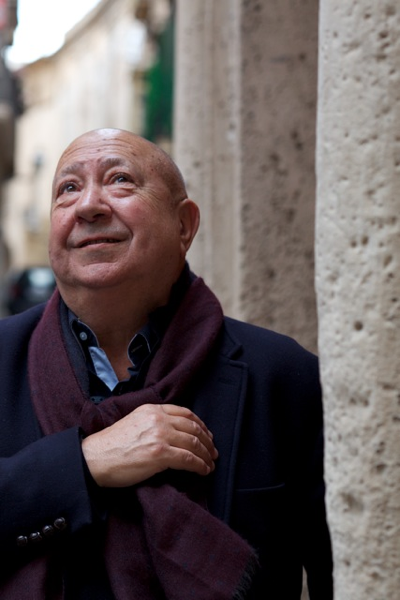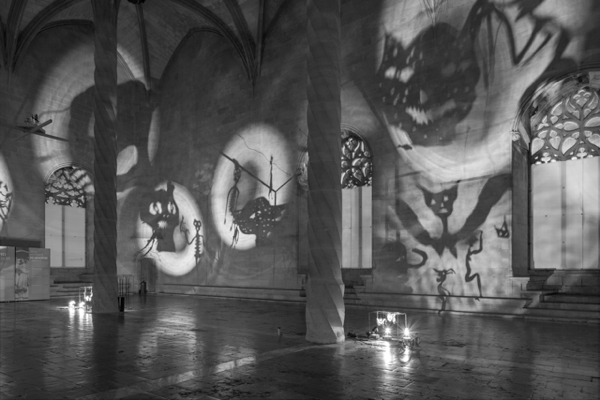Art & Exhibitions
artnet Asks: Christian Boltanski
The veteran French artist discusses his behemoth Danse Macabre in Palma de Mallorca.

The veteran French artist discusses his behemoth Danse Macabre in Palma de Mallorca.

Coline Milliard

Christian Boltanski belongs to the handful of artists who have reached the status of being French national treasures. Often tinted by the memory of the Holocaust, his installations, sculptures, and assemblages tackle the big questions: mortality, remembrance, and the fragile miracle of human existence. For his latest project, Sombras, he has installed a haunting shadow theatre in the Gothic masterpiece of La Lonja, an old market in Palma de Mallorca. artnet News called up the artist to find out more.
How did you approach the building?
It’s a challenging building: it’s extremely beautiful, and since it’s an historical building, you cannot use nails inside—and I can’t stand fake walls. I think one has to respect the building, and work with it as if in a sort of collage. It’s also an ancient market, and I believe the largest civil space in the area. This made me think of the Middle Ages’ danses macabres. What was important for me was that the building is open to the public: it’s not a museum, anyone can wander in. So I wanted to do something that would also be a little playful: linked to this idea of the Middle Ages, but with a light touch—and something that would show the building off.
Working with shadows is almost a non-intervention, since they are there without being there.
It’s intangible. So in the installation, there are these ridiculously tiny theatres and gigantic shadows on the wall.
The shadow theater is a motif that you started using in the mid-1980s. How do you approach a piece that has already existed?
You know, when you are asked a question, which is an exhibition, you have to look into the fridge, which is your head, and check out what’s in there. And indeed each time, it’s the same thing and not the same thing. For La Lonja, I’ve done 60 new little cut out dolls in copper. I added a talking clock—also an old piece, since I did it for the first time about 10 years ago—which says the time, like: “It’s five o’clock, 10 minutes, and 20 seconds. It’s five o’clock, 10 minutes and 30 seconds.”

Installation views of the exhibition “Sombras” by Christian Boltanski, La Lonja, Palma de Mallorca, Januar 2015
© Christian Boltanski; © Foto: Stefan Müller; Courtesy: Kewenig, Berlin/Palma de Mallorca
And that’s what visitors hear in the space.
Yes. It’s the idea of time that cannot be stopped but eventually stops for us, and is a sort of infernal machine. I installed something like that under the Salzburg Cathedral, about eight years ago. I told the Bishop of Salzburg it was the image of God: God is the master of time.
How did he take it?
As you can imagine, it was a little difficult for him to accept a talking clock in the church’s crypt at the beginning, but I convinced him.
Some of your recent projects, like the Heart Archive (2008-ongoing) in Naoshima, Japan, have a much longer temporality. Is this a way to capture time, or fight it?
There’s also my project with Tasmania, for which I’m filmed night and day in my studio—and which will be my ultimate project since it will end when I die (Les Derniers Jours de C.B. [C.B’s Last Days]). But to answer you question: yes, I have two kinds of activities at the moment: temporary exhibitions, like the show in São Paulo (“Boltanski 19.924.458 +/-,” 2014) of which nothing remains, and permanent works, which are like some sort of tombs, located very far away: in Japan, or in Chile, such as the project I’ve just completed in the Atacama Desert (Animitas).
Do you think that the older you get, the more inspired you are by these kind of long-term projects?
There is this idea of the ephemeral, and this desire, no doubt, to create permanent sites but that are … the visitors at Naoshima don’t even know who did [The Heart Archive]. For them, these pieces become places of pilgrimage. There are 850 bells in the Atacama Desert and for the few Indians there it’s a sort of … cemetery. But a cemetery for whom? For what?